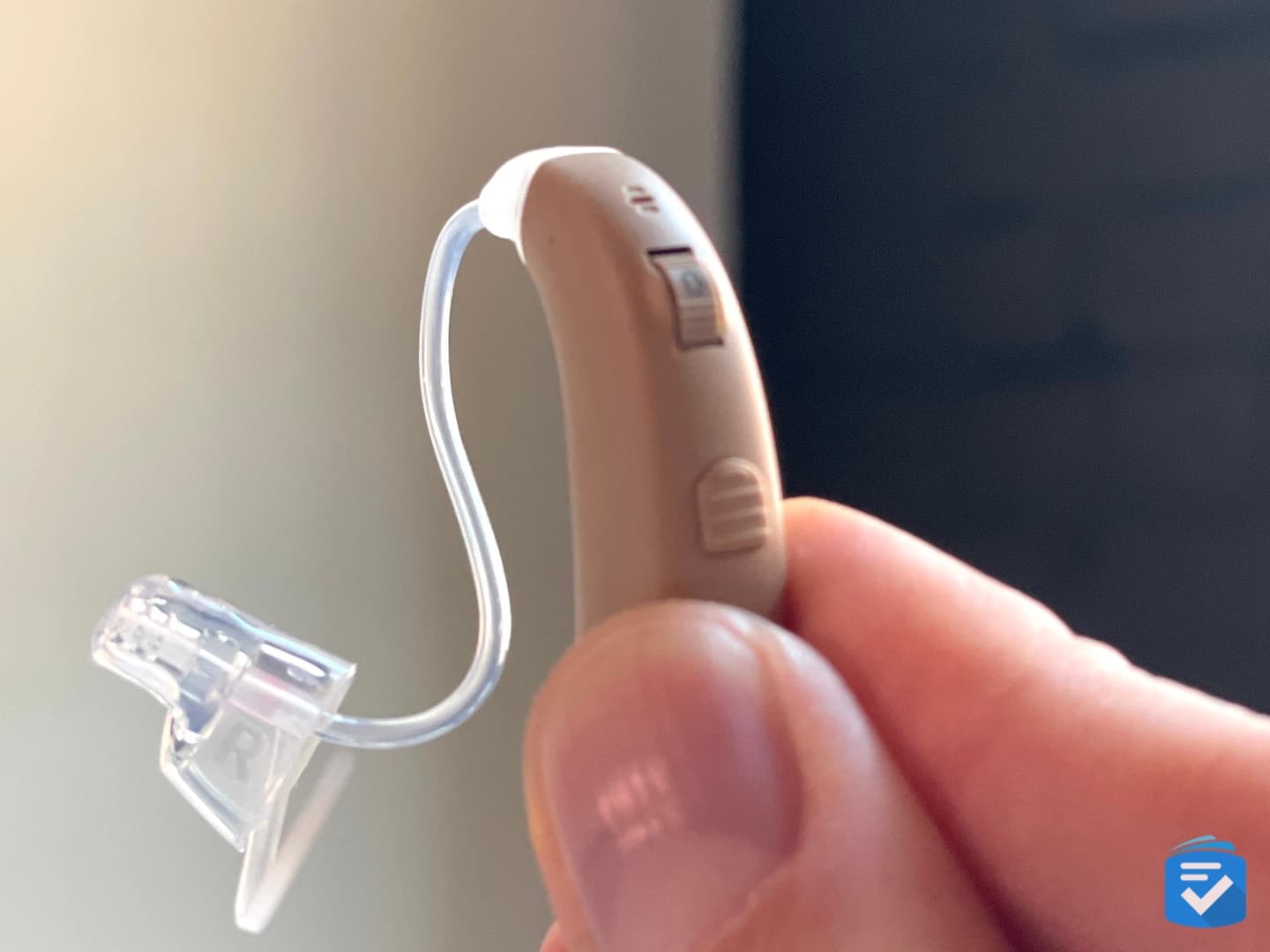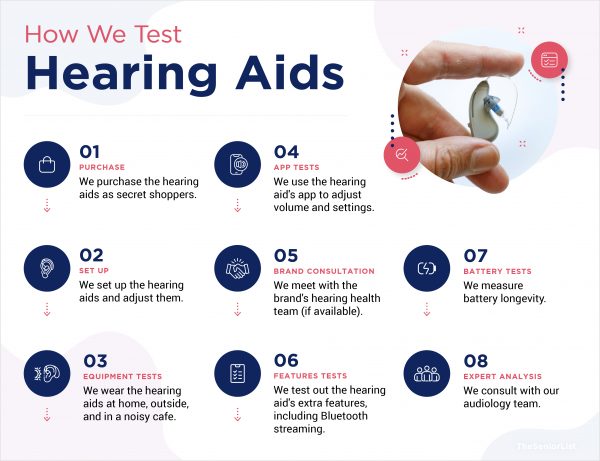The Best Hearing Aids for Single-Sided Hearing Loss in 2025 (Audiologist Reviewed)

Key Findings
- People with unilateral hearing loss can benefit from hearing aids with CROS systems — a specialized technology that helps users with impaired hearing in one ear better understand speech and sounds around them.
- Alternatively, a single hearing aid can have a similar effect.
- In our experience, Phonak, Oticon, and MDHearing offer the best solutions for unilateral hearing loss.
FYI: If you’re looking for more broad information about hearing aids, then check out our rundown of this year’s best hearing aids overall.
Why Trust TheSeniorList?

When choosing the best hearing aid providers for unilateral hearing loss, we rated companies on the following:
- CROS systems: We looked at hearing aid companies that accommodate individuals with one-sided hearing loss. That includes using the latest CROS system technology to amplify sounds and create a pleasant hearing experience.
- Affordability: We looked into companies that offer affordable financing options or one-time payments from $399.98 per pair.
- Single hearing aid purchases: In some cases, a single hearing aid can be an effective way to manage one-sided hearing loss, so we looked for companies that offer single — as opposed to pair — purchases.
One-Sided Hearing Loss Hearing Aids Compared
|
Phonak
 |
Oticon
|
MDHearing
 |
|
|---|---|---|---|
| Rating out of 5 | 4.4 | 4.0 | 4.6 |
| Cost for a Pair | $1,300 – $4,000 |
$825 – $3,900 |
$297 – $397 |
| Warranty | One-year limited warranty* |
One-year limited warranty* |
90 days |
| Features for One-Sided Hearing Loss |
|
|
|
| Read More | Phonak Review | MDHearing Review |
*Warranties for prescription hearing aids will vary by the retailer.
The Best Hearing Aids for One-Sided Hearing Loss in 2025
1. Phonak - Best Unilateral Hearing Loss Solution
 View Pricing
Links to ZipHearing.com
View Pricing
Links to ZipHearing.com
What We Like Most:
- Custom fits for unilateral hearing loss
- Smartphone connectivity
- Great sound quality
- Solutions from mild to profound hearing loss

Overview
Cost: $3,000 to $6,000 for a pair
Phonak offers a wide range of hearing aids for varied hearing loss, but it also caters to individuals with unilateral hearing loss. Phonak’s latest model, the CROS Lumity, helps you hear all the sounds around you with ease. The CROS Lumity is available as a rechargeable aid, and it is compatible with Phonak’s Lumity hearing aids; this means it can stream audio from a cell phone.
With the Phonak CROS Lumity, you can enjoy hearing full sounds and voices with the switch of a button. The device consists of a microphone that picks up sound from the hearing-loss ear and sends it to the other ear outfitted with a hearing aid. The discreet Phonak CROS Lumity is designed to improve awareness of sounds and speech around you. Since it uses Phonak AutoSense OS technology, the hearing aid makes it easier to distinguish sounds and hear clearly. CROS Lumity is designed to automatically detect various listening environments and switch to the best setting. Other features include zooming in on various voices for focused speech at restaurants and in other hard-to-hear situations.
Contact Phonak for the latest pricing. The company currently offers a one-year limited international warranty; the length of the local warranty depends on the provider you purchased your Phonak hearing aids from.
Pros
- High-performing noise reduction
- One-year minimum warranty
- Advanced noise cancellation
- Bluetooth streaming
Cons
- Must be purchased from a hearing specialist
- Higher costs than OTC models
2. Oticon - Best Immersive Sound Experience
What We Like Most:
- Range of CROS and BiCROS solutions
- Smart features
- Multiple style options
- Music, TV, and call streaming
Overview
Cost: $825 to $3,900 for a pair
Oticon is known for its innovative BrainHearing technology, which supports the brain’s natural way of making sense of sounds. Among Oticon’s broad range of hearing aids are devices geared toward users with one-sided hearing loss for an immersive, high-quality sound experience.
Oticon CROS works by way of a wireless transmitter and hearing aid that picks up sound, which is then sent from the impaired ear to the better ear. With Oticon CROS, users with unilateral hearing loss can have access to advanced features such as wireless streaming and natural, clear sounds in a variety of environments. Oticon CROS uses advanced dual-streaming technology to help you listen to music, watch TV, or have a full conversation without missing a word. I recommend the Oticon CROS system for an immersive wireless streaming experience.
Pricing for Oticon devices varies depending on the model and features, but it’s generally between $825 and $3,900. The warranty will depend on where you purchased your Oticon hearing aids. Oticon offers great customer service and technology geared toward changing and improving the lives of people with hearing loss. For hearing tests and other hearing aid assistance, Oticon partners with a wide range of hearing health care providers.
Pros
- Great sound quality
- Stellar noise cancellation
- Discreet options available
- Risk-free trials
Cons
- Higher price tag
- Must be prescribed
Pro Tip: Want to learn more about Oticon’s unique features and pricing? Read our latest Oticon Hearing Aid Cost and Pricing article.
3. MDHearing - Best Budget Option
What We Like Most:
- Single hearing aid purchases
- Incredibly affordable
- Lifetime remote support
- Four environment settings
Overview
Cost for a pair: $297-$397
MDHearingAid offers affordable hearing-loss solutions for people with unilateral hearing loss. Many online hearing aid companies require you to purchase a pair of hearing aids, but you can purchase a single device with MDHearingAid.
If you have mild to moderate one-sided hearing loss, then you may want to look into MDHearingAid’s basic model, Air; this can be purchased as a single hearing aid for unilateral hearing loss. It also has a virtually invisible design that delivers high-quality sound when you’re in a variety of settings, such as a restaurant, theater, or large crowd.
Using this hearing aid on your ear with hearing loss can help amplify voices over background noise; this allows you to focus on important conversations without being distracted. Other standout features include three environmental setting options — quiet, noisy, and social — to customize your hearing aid.
The MDHearingAid Air starts at a one-time payment of $399.99 for a single device. MDHearingAid offers a 90-day warranty against material defects and workmanship, as well as U.S.-based customer service with 24/7 support whenever you need it.
To learn more about MDHearingAid, read our MDHearingAid review.
Pros
- Remote audiologist fittings
- BTE and invisible styles
- No smartphone required
- Highly affordable
Cons
- No Bluetooth features
- Maximum 90-day warranty
Honorable Mentions
The following hearing aids performed well in our tests. For the right user, they might be worth a look.
- Widex: Widex hearing aids include CROS models. If you’re willing to pay potentially high costs for your devices, then these can be an effective solution.
- Jabra Enhance: In our Jabra Enhance hearing aid review, we were impressed by the sound quality and customer support for this OTC hearing aid brand; however, they do not offer specific solutions for those with one-sided hearing loss.
- Eargo: Eargo hearing aids can be easily adjusted from a smartphone app; however, much like Jabra, they don’t offer CROS solutions. Read our Eargo review to learn more.
What Is Unilateral Hearing Loss?
An estimated 60,000 Americans of all ages have unilateral hearing loss. Unilateral hearing loss, also known as one-sided hearing loss, is when an individual experiences normal hearing in one ear and any amount of hearing loss in the other ear. One-sided hearing loss can require special technology to restore clear sound and speech.
If you have mild or moderate unilateral hearing loss, then a single hearing aid on that ear may work well for you. Unfortunately, not all traditional hearing aids cater to users with moderate or severe unilateral hearing loss, so consider hearing aids that use CROS technology.
CROS Hearing Aids
Several hearing aid brands have devices outfitted with CROS technology, which is designed specifically for users who have unilateral hearing loss. Some top hearing aid companies that offer CROS systems include Oticon, Phonak, and Widex.
As mentioned, CROS technology works by taking the sound in the ear experiencing hearing loss and sending it to the unaffected ear. CROS hearing aids are worn either in or behind both ears, depending on the style.

FYI: If you’re on a budget and you’re looking for affordable hearing aids for one-sided hearing loss and other types of hearing loss, read our guide to the most affordable hearing aids.
Bottom Line
Users with one-sided hearing loss can greatly benefit from either a single aid or hearing aids equipped with CROS technology. I recommend looking into providers such as MDHearing, Phonak, and Oticon, which offer affordable solutions for individuals experiencing unilateral hearing loss. If you or a loved one has severe or profound hearing loss, I recommend reading our article Best Hearing Aids for Severe to Profound Hearing Loss. If you’re looking for a new smartphone that’s compatible with select hearing aids, then take a look at my article Best iPhones for Seniors.
Frequently Asked Questions
-
Do hearing aids help unilateral hearing loss?
Yes, there are many options for single hearing aid purchases through companies such as MDHearingAid. If you have normal hearing in one ear and severely impaired hearing in the other, then it’s recommended to get a specialized hearing aid.
-
Can you get a hearing aid if you are deaf in one ear?
Hearing aids outfitted with CROS technology can help significantly improve the hearing experience of individuals who are deaf in one ear by sending the sound to the normal ear.
-
Is unilateral hearing loss considered deaf?
Unilateral hearing loss refers to single-sided hearing loss — mild to profound — in one ear. An individual can have reduced hearing or experience significant hearing loss in one ear.
-
Can hearing loss in one ear be cured?
There is no cure for hearing loss, but there are several hearing aids you can use to help amplify sounds and better distinguish speech.
-
How can I improve my hearing in one ear?
You can protect the hearing you have by keeping your ears free of wax and keeping the volume of headphones and hearing aids at lower levels.
